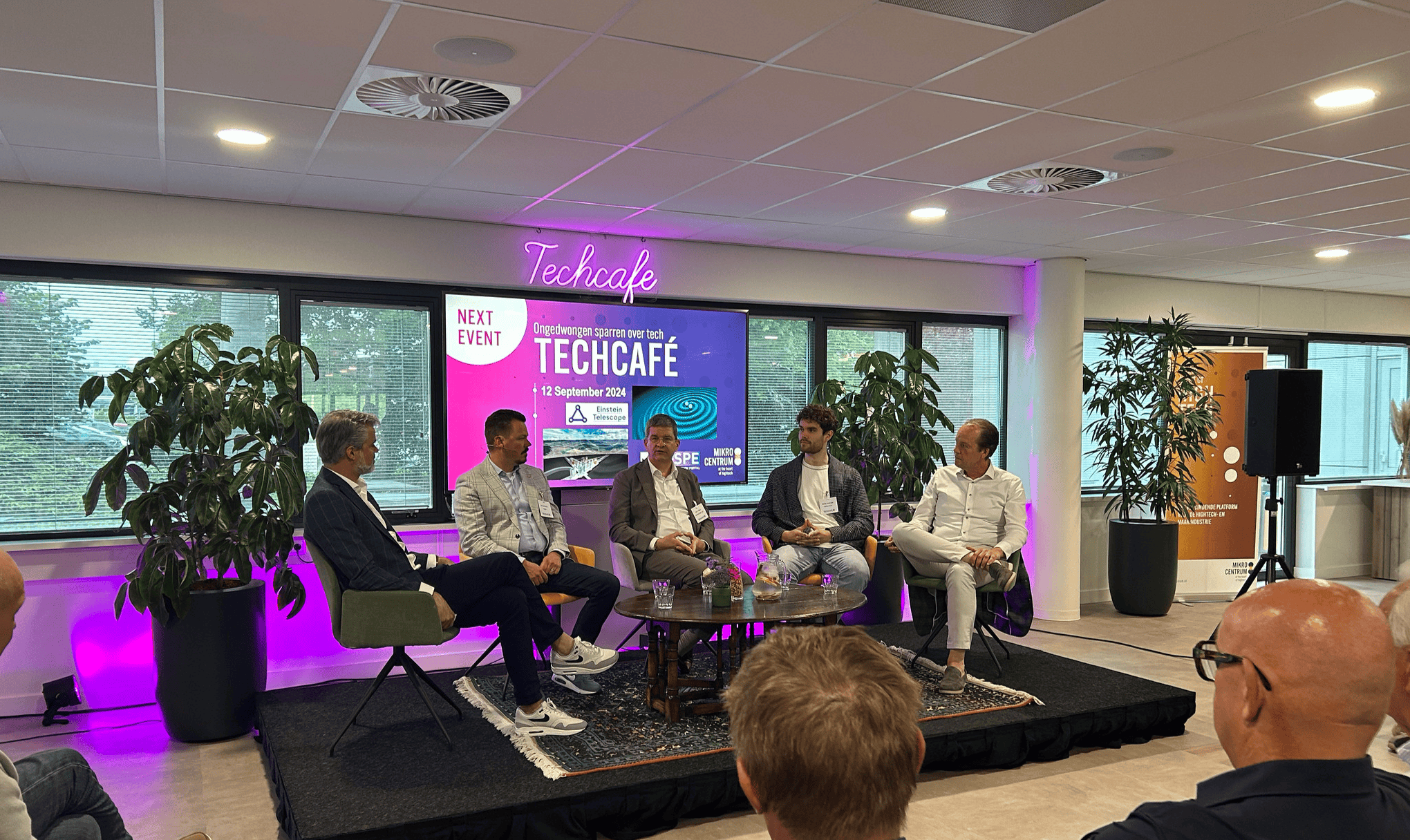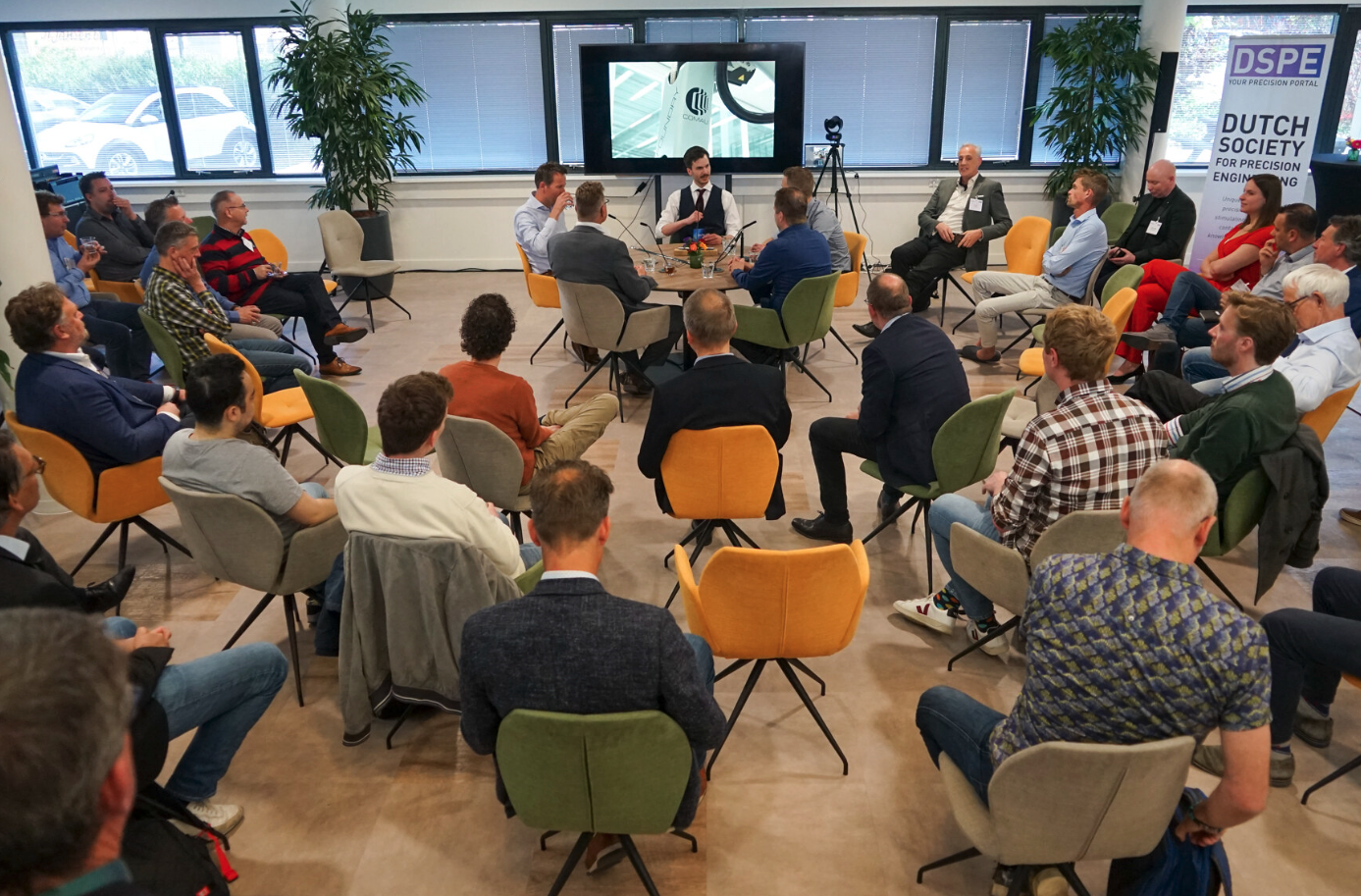
In the eighth Techcafé, five experienced entrepreneurs discuss how they turned their high-tech start-ups into successful businesses. Paul van Dooren (Sorama), Henk Tappel (Bronkhorst), Martijn Huijbregts (iTapToo), and Patrick Geerts (MTA Group) shared their challenges and successes with host Edwin de Zeeuw (Mikrocentrum).
Why you should read this
Even with dozens of books and pitching contests around every corner, it remains helpful to learn from the experience of peers. Techcafé is facilitating just that.
In the dynamic world of high-tech start-ups, the path to success is littered with challenges and unexpected obstacles. During this Techcafé, organized by DSPE, Brainport Industries, and Mikrocentrum, five prominent entrepreneurs shared their experiences and insights on how they turned their innovative ideas into thriving businesses.
From idea to market introduction
Sorama’s Paul van Dooren told the audience how the company started with acoustic cameras that make sound visible. “We wanted to do something in safety and security, but that didn’t always catch on immediately. A good example is PSV: it was only when we pitched the idea to show the fans how excited they were that we got the commercial director on board,” Van Dooren said. This technology is now being used not only in the Philips Stadium but also in a new basketball stadium in Los Angeles. Currently, Sorama is working in both security and entertainment.

Henk Tappel of Bronkhorst High-Tech emphasized the importance of local production and quality assurance. “At Bronckhorst, we make everything with a local supply chain. This ensures reliable products and strong ties to the community,” Tappel said. His experience at Philips Electron Optics and later at Thermo Fisher illustrates how crucial thorough product development and customer loyalty are.
Martijn Huijbregts, the co-founder of iTapToo, described how his company began out of the frustration of students who had to buy expensive soft drinks. “Why not fill your own bottle with a tasty flavor? We developed a system that makes soft drinks from powder and water from that thought,” Huijbregts told the audience. The company grew quickly and now has nearly a hundred machines in the market.
Patrick Geerts, co-founder of the MTA Group, revealed that many startups have no idea what it takes to get from idea to success. “Some think: put a bunch of techies together, add a bag of money and we’re going to solve a global challenge with that great idea of ours. There is so much more that needs to be done, especially around the go-to-market strategy and sales. That’s where we help them.”
Ingredients for success
A recurring theme during the café was the importance of perseverance and a good team. Patrick Geerts: “The team is crucial. We look at the competencies and the complete composition. The go-to-market strategy is essential. Many startups focus on technology but forget about the market launch.”
Geerts introduced the V-squared model, which supports companies from innovation to series production. “We support companies from inception to series production, especially the entrepreneurs who address social issues through automation and robotization,” Geerts explained.

Student teams
Everyone at the table agreed about the importance of student teams as a place where not only many new ideas arise but where the foundation for future leadership is laid as well. Geerts praised the principle of those students to put their studies on hold for a year to do everything possible to achieve their goals during that time together with other students from all kinds of disciplines. “They all end up in our ecosystem after their studies. And not just to start their own company but also for a job at the somewhat larger corporates. To do their bit there on the roadmap for innovation.”
Build, measure, learn
The everlasting cycle of build, measure, learn, prominent in every startup handbook, is still proving to be valuable. Although it also has its drawbacks, the conclusion was: “Working iteratively and testing with your customers has its risks. By entering the market too early, you can also lose customers. On the other hand, it does provide a lot of valuable feedback.” The dilemma is apparent, but the principle is not questioned for now.
Huijbregts added that testing new products in a real environment is crucial but also risky. “In a factory, things can go well, but that’s not always the case at the customer’s place. Having the guts to test and learn from mistakes is essential,” Huijbregts said.
The road to success is rarely without obstacles. Tappel emphasized that internal resistance in larger companies is often a challenge. “You need visionary people in top management who clear obstacles for the team.”
The next Techcafé – on 12 September 2024 – is all about the Einstein Telescope. Sign up here.

